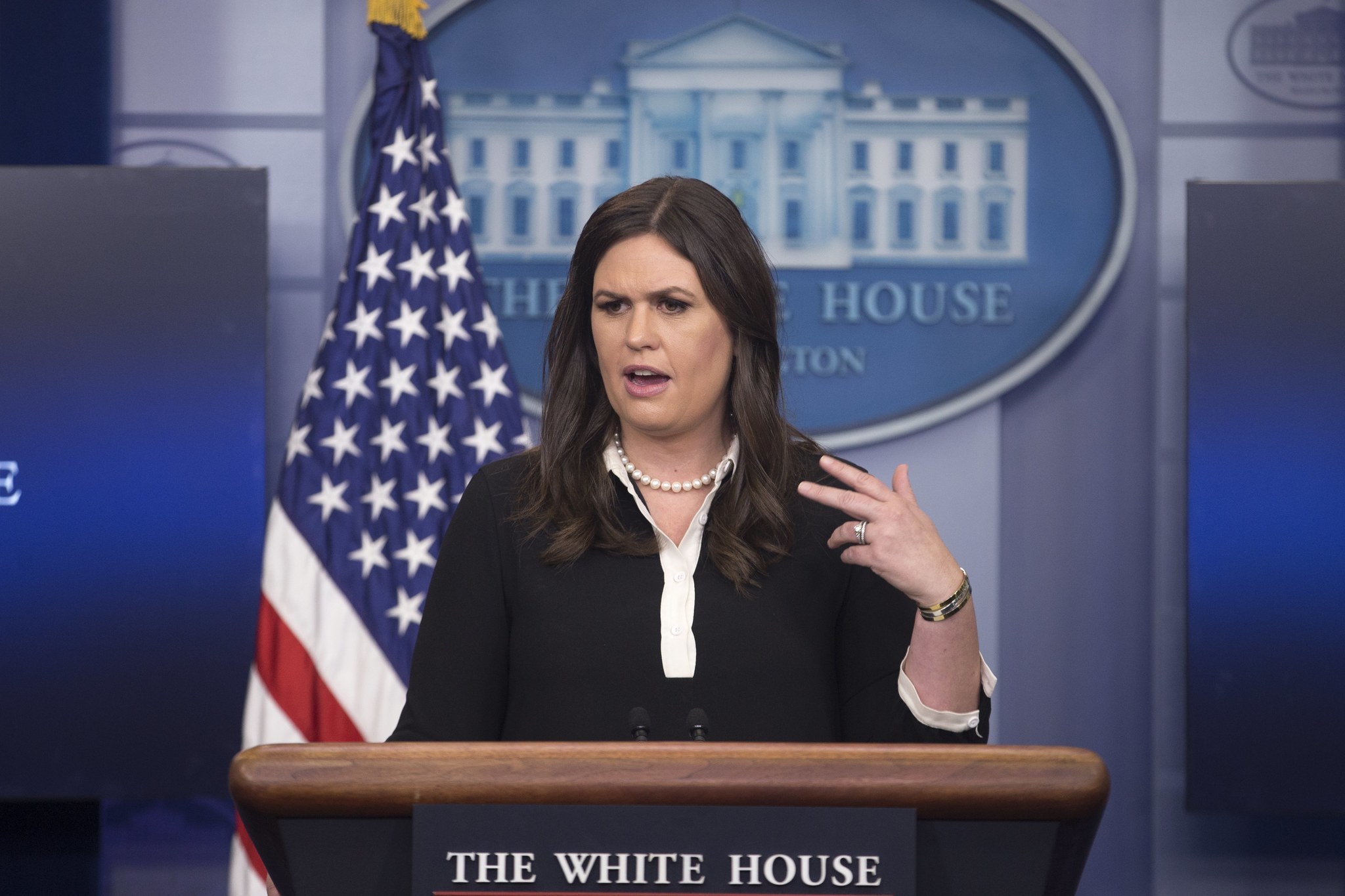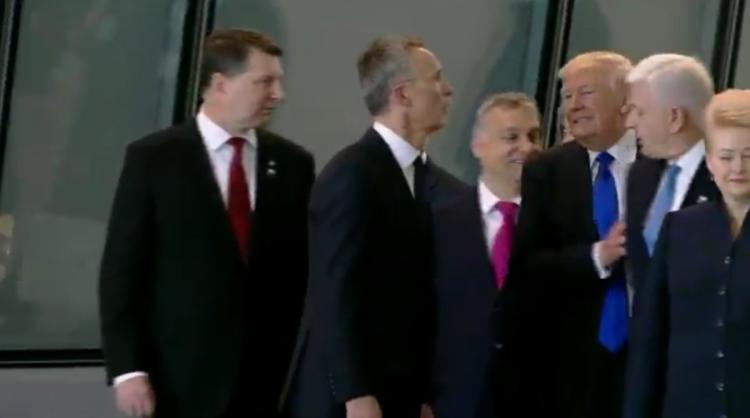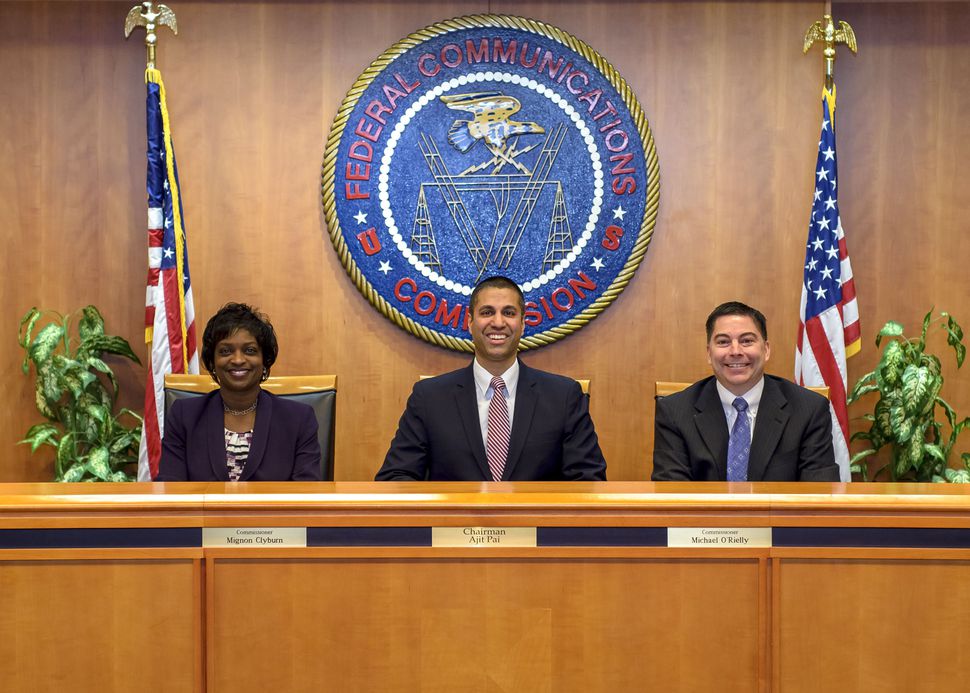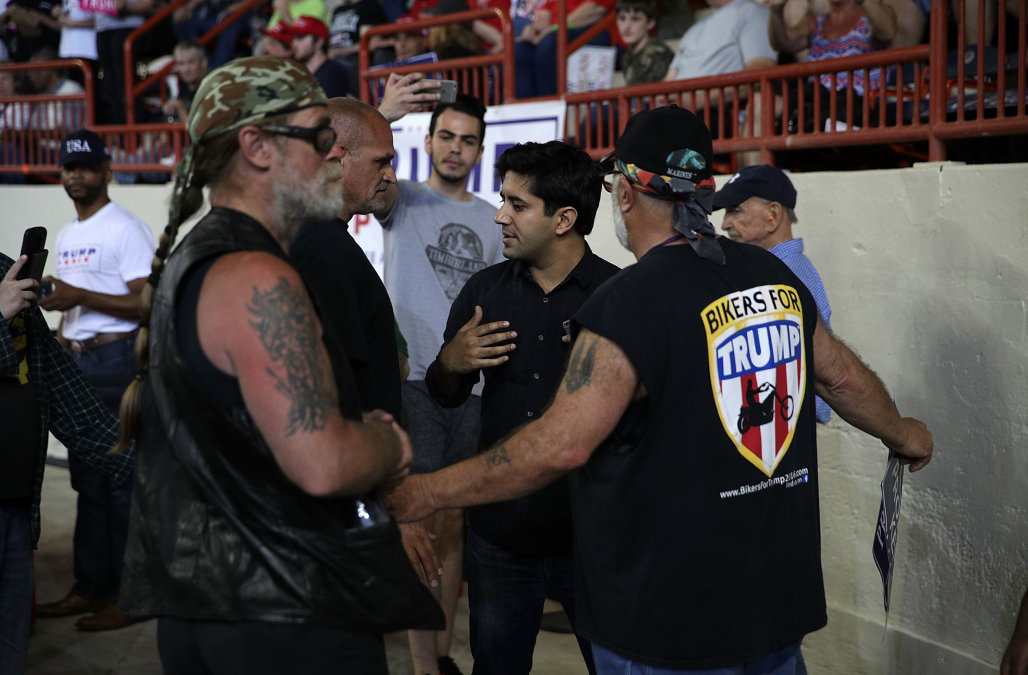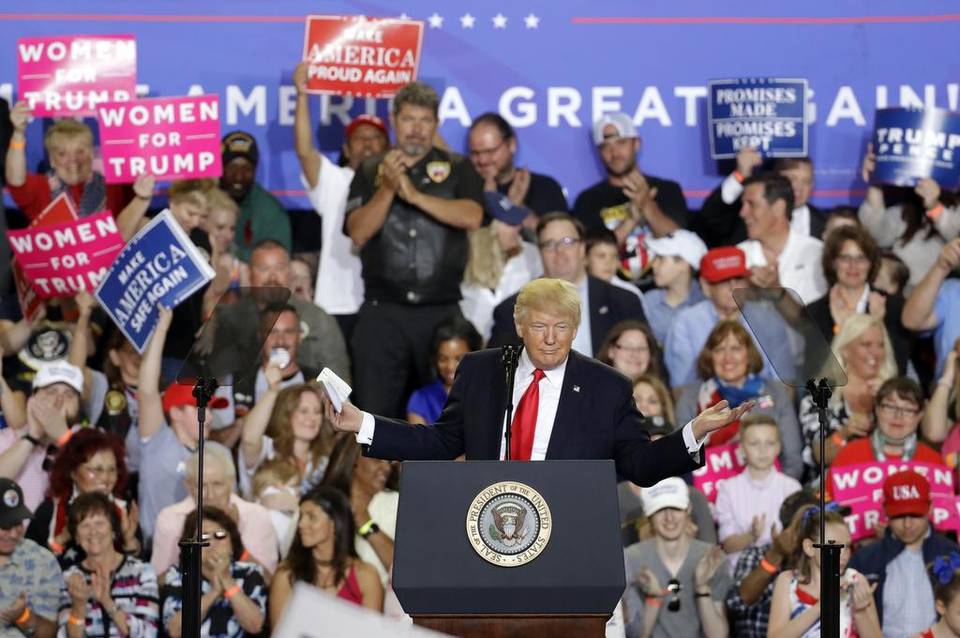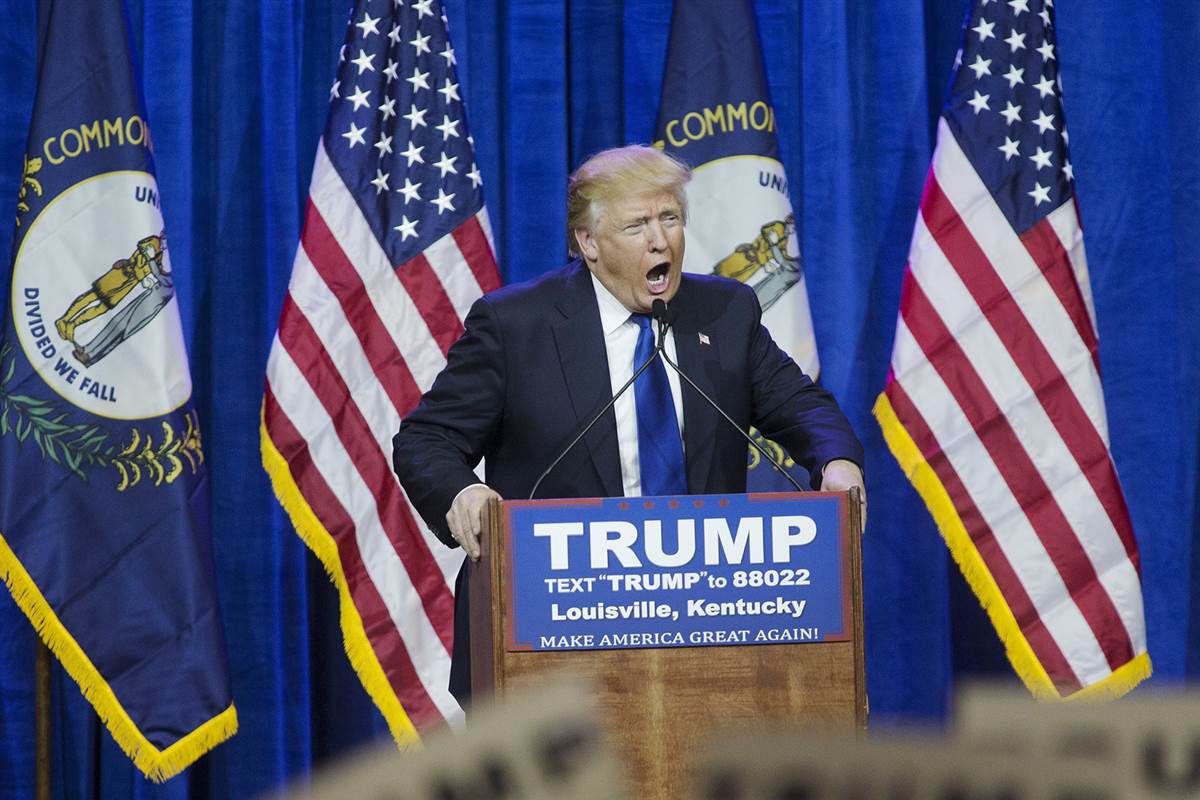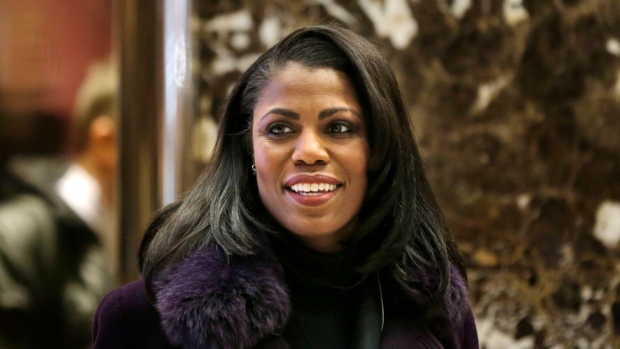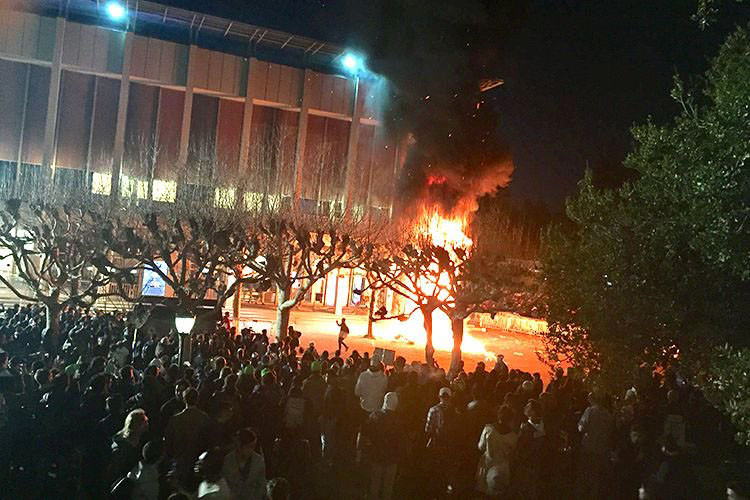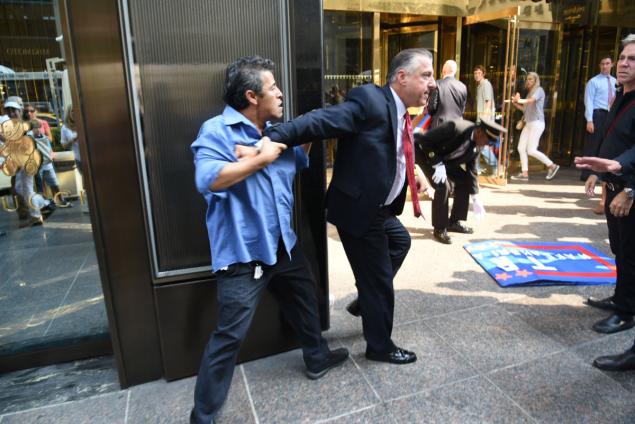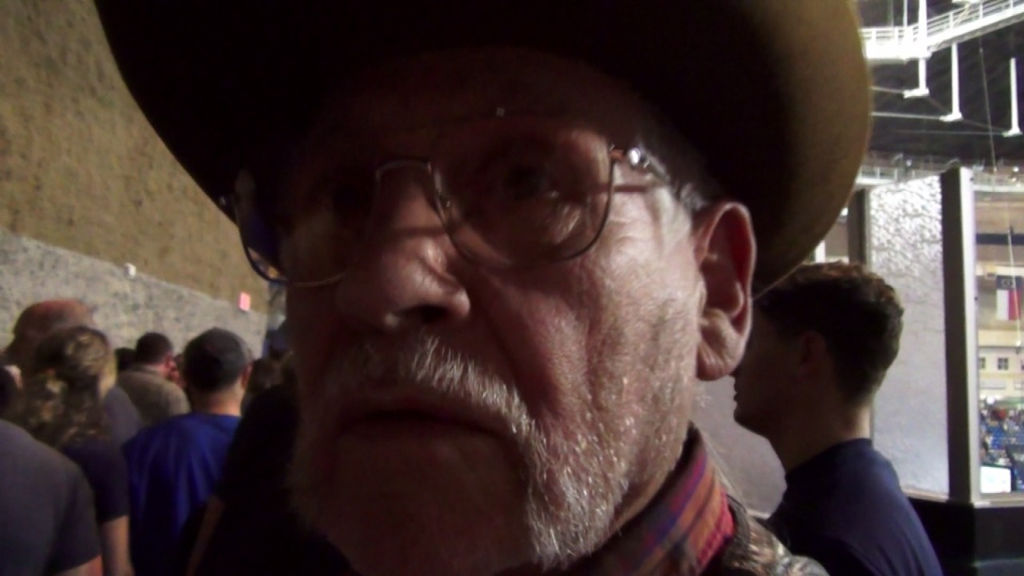Donald Trump’s private security lacked basic procedures and policies — including for the use of force — giving guards free rein during the campaign and transition to physically confront protesters and journalists they found objectionable, according to hours of deposition transcripts in a civil lawsuit that were reviewed by POLITICO.
For instance, during a September 2015 protest outside Trump Tower, Trump security guard Gary Uher forcibly escorted a protester away from the building’s entrance because he believed — incorrectly — that the adjacent sidewalk was Trump’s property, according to his testimony. Uher said he was authorized by the campaign to use force to move the protesters, but in a separate deposition, Trump’s security director at the time, Keith Schiller, said Uher had no such authorization.
Yet Schiller, who joined Trump’s White House staff last month, explained that he decided to place his hands on Univision’s Jorge Ramos while ejecting him from an August 2015 press conference because Ramos was “not listening or not being cordial or respectful to Mr. Trump or his colleagues, because he spoke out of term (sic).”
And Trump Organization executive Matthew Calamari, to whom Trump testified in an affidavit he had delegated “full responsibility and authority for the hiring and supervision of all security personnel,” said the last time Trump’s operation produced a “security procedures” document was during the 1990s, and that it’s long been out of use. “I haven’t seen it in many, many years,” testified Calamari in his deposition. While he claimed that all of Trump’s security personnel are licensed as security guards by New York state, Uher, Schiller and another security official said in their depositions that they did not have such licenses when they responded to the September 2015 protest.
The sworn testimony was ordered in connection with a lawsuit brought in New York State court against the guards, the Trump Organization, the Trump campaign and Trump himself by participants in the September 2015 Trump Tower protest. The protesters claim they were “violently attacked” by Trump’s security “for the express purpose of interfering with their political speech.”
Schiller, Uher and the Trump Organization did not respond to requests for comment. In their depositions, the security officers claim that they were just trying to keep the sidewalk clear for pedestrians and got physical only when protesters refused to clear the sidewalk and one accosted Schiller.
Yet the depositions paint a picture of a security operation guided more by instinct than procedures, where employees were not subject to background checks or regular evaluations, and where lines were blurred between Trump’s campaign, his corporation and even the United States Secret Service.
All of the officials deposed in the lawsuit continued working for Trump in some capacity after his Election Day victory, and at least two remained involved in some facet of Trump’s operations after he was sworn in as president last month.
Schiller, a retired New York City detective, began work last month as Trump’s director of Oval Office operations while Calamari continued as the Trump Organization’s executive vice president and chief operating officer, a position from which he oversees the company’s security apparatus. Uher suggested in his deposition that he too had gone to work for the company after the election.
Hope Hicks, the White House director of strategic communications, stressed that Schiller’s new White House job “does not entail any security-related functions” and that he “is in compliance with all rules applied to White House staff.” She referred questions about security personnel and functions to the Trump Organization and the Secret Service.
The Trump Organization did not respond to multiple requests for comment.
A Secret Service spokesperson stressed that the agency has sole authority to protect the president and his family but explained that it would coordinate with Schiller and other members of the president’s staff as well as “any private security organization responsible for the protection of facilities where a USSS protectee will be present.”
The depositions and the underlying lawsuit — one of at least three winding through federal and state courts brought by protesters against Trump, his campaign or its security — are likely to fuel scrutiny of Trump’s private security. It has drawn repeated complaints for excessive force and aggression, racial profiling and trampling free speech. And its relationship with the Secret Service has raised concerns among agency employees, outside law enforcement experts and members of Congress overseeing the agency, who worry that the private security may have complicated the service’s ability to protect Trump during the campaign and transition.
“I’m surprised that apparently these people have been around the Secret Service all along,” said Del. Eleanor Holmes Norton (D-D.C.) during an interview on Washington’s NewsChannel 8 in December. “Who’s in charge if you have your long-term guards and the Secret Service?” she asked in response to a POLITICO article revealing that Trump had retained private security even after winning the presidency.
Norton, who sits on the House subcommittee that oversees the Secret Service, did not respond to a request for comment from POLITICO. But she told NewsChannel 8 that she intended to push the committee to investigate “how were they used during the campaign? Who was in charge then, because I understand that they had a role in the campaign that I did not know of, and I don’t believe the Congress knew of.”
POLITICO, in conjunction with the nonpartisan transparency organization the James Madison Project, on Monday sued the Secret Service under the Freedom of Information Act for public records detailing the agency’s relationship with Trump’s private security.
While the Secret Service assumed responsibility for Trump’s personal security in November 2015, some members of Trump’s private security detail continued traveling with him, while others continued providing security at rallies in conjunction with the service — highly unusual moves for a presidential campaign.
Schiller, in particular, appeared to continue acting as if he had a security function throughout the campaign. That raised concerns among Secret Service agents, who said Schiller bristled at their efforts to take charge and got in their way at times, according to a law enforcement official who communicates regularly with the agency’s agents.
The agency’s director, Joseph Clancy, suggested in a CNN interview last month that Trump’s private security stepped back when Secret Service assumed protection in November 2015. The private security wouldn’t have intervened if there were a threat to Trump, asserted Clancy, casting Schiller as a “conduit for information” between Trump and his agents.
Clancy told CNN that there was “no friction at all” between his agents and Trump’s private security. He declared that his agents “only work with the law enforcement partners” and “don’t interact with” Trump’s private security.
But some of Clancy’s own agents took umbrage at Clancy’s pushback, which they interpreted as an effort to minimize serious concerns about Trump’s private security in an effort to make nice with the new boss, according to the law enforcement official. Clancy’s comments on CNN “were in line with his efforts to try to keep issues out of the media and move on from an issue rather than address the matter,” said the law enforcement official.
In fact, Clancy’s assessment appears to be at odds with the depositions, as well as legal filings in other cases and POLITICO’s own reporting.
Eddie Deck, a former Marine and FBI agent, testified in the Trump Tower protest case that, after the Secret Service granted protection to Trump, Deck’s job changed from providing such protection to doing security at Trump events, including being a “liaison with the police and the Secret Service.”
In his deposition, Deck explained that his contract calls for him “to do the coordination with the police department or Secret Service for the safety and security at the Trump rallies.”
And Deck, whose policing of Trump rallies drew repeated complaints from protesters for using excessive force and ejecting people solely because they didn’t look like Trump supporters, suggested that he and the Secret Service were involved in a decision to cancel a March 2016 rally in Chicago amid raucous protests — both outside and inside the arena.
“It created such an unsafe environment, that Mr. Trump did not come due to my advisement and Secret Service’s advisement, because it would’ve been very, very, very unsafe,” said Deck.
Deck did not respond to a request for comment, while a Secret Service spokesperson said Deck was not involved in the agency’s security planning or decision-making. “During the campaign, Mr. Deck was considered a staff member,” the spokesperson said, adding “staff members serve different functions of which being a liaison with USSS or local police might be one.”
And although Clancy told CNN that the Secret Service wouldn’t get involved in ejecting protesters who weren’t a threat to Trump because “We want to make sure everyone has their First Amendment rights,” Trump’s own lawyers suggested he saw things otherwise.
In a filing in a case brought by three protesters roughed up and ejected by Trump supporters from a March 2016 rally in Louisville, Kentucky, after Trump barked “get ’em out!,” Trump’s lawyers wrote that “Mr. Trump was calling on the Secret Service, event security, and local law enforcement to enforce the law and remove hecklers who were ruining the event for others.”
The Secret Service spokesperson said that the agency “will not impede the First Amendment right of protesters and will only engage if a verbal or active threat is directed toward a protectee.” Decisions about whether to remove disruptive protesters are made “at the discretion of the host committee,” the spokesperson said, adding that agents “would not be involved in the removal of those individuals.”
The fact that the Kentucky rally was held in a private venue using Trump campaign funds meant that once the protesters voiced anti-Trump sentiments, they became trespassers, according to the filing by Trump’s lawyers. And that “gave Mr. Trump and the Campaign the legal right to remove the protesters by force,” Trump’s lawyers argued. Nonetheless, video shows the lead plaintiff, a young African-American woman named Kashiya Nwanguma, was mostly forced from the arena by Trump supporters who shoved and taunted her as she made her way toward the exit.
Nwanguma alleges in the suit that she was subject to racial epithets and other slurs during the ordeal. And her lawyer Daniel J. Canon argued in an interview that what happened to Nwanguma represented a failure of Trump’s private security and local police.
“Part of the problem here is that they weren’t removed by private security,” said Canon. “Instead, they just let this angry mob of white people attack this black person who was protesting,” said Canon, who brought the suit against Trump, his campaign and three attendees, one of whom is a well-known white nationalist.
“The idea that a presidential candidate goes on the road and makes campaign stops and asks or commands the crowd to turn on peaceful protesters who are in the audience is beyond the pale, especially when you know that you’ve got a powder keg on the ground of white supremacists and other violent people and groups,” he said.
The protesters who clashed with Trump’s security outside Trump Tower in September 2015 also contend that the security is a reflection of Trump himself.
The protest was motivated by Trump’s incendiary claims about Mexicans, and it included a pair of protesters dressed in paper facsimiles of Ku Klux Klan robes and hoods, while others carried signs declaring Trump a racist.
After mistakenly informing the protesters that the Trump Tower sidewalk was private property, Uher escorted one of the protesters in a KKK costume away from the building, inside of which Trump was holding a press conference to announce that he’d signed a loyalty pledge to support the Republican Party’s presidential nominee — even if it wasn’t him.
Uher argued in his deposition that the situation required him to put his hands on the protester. “Yeah, I’m sure I touched him… just to advise him that we had to keep moving,” said Uher, explaining “my hands weren’t on him the whole time. As I invaded his space, he was — he moved.”
Schiller demanded that protesters remove an 8-foot-long sign mimicking Trump’s campaign logo, but instead reading “Make America Racist Again.” When they didn’t comply, he aggressively grabbed and ripped the sign, turned and began walking with it toward Trump Tower.
One of the protesters, Efrain Galicia, pursued Schiller, grabbing him from behind in “an attempt to retrieve the [sign] before Schiller could abscond with it into Trump Tower,” according to a legal complaint filed by lawyers for Galicia and others who protested with him. Video shows Schiller quickly pivoting and striking Galicia in the head. Schiller explained in an affidavit that he did so “instinctively” and “based on … years of training” because he felt Galicia’s “hand on my firearm, which was strapped on the right side of my rib cage in a body holster.”
Though Schiller admitted in his deposition that his gun was concealed beneath a loose-fitting suit jacket, he contended that Galicia “could have seen the bulge” from the weapon through his jacket.
Deck quickly grabbed Galicia around the neck, holding him back, because, Deck argued in his deposition, Galicia “had already jumped and assaulted Mr. Schiller,” though Deck also conceded it was unclear whether Galicia knew Schiller was armed.
Deck, Schiller and Uher all explained in their depositions that they were trying to clear the sidewalk because the protesters were impeding foot traffic, though the protesters’ lawyers argue there was ample room for passersby to walk past.
“It was mayhem out there,” Deck said.
But Galicia suggested to reporters at the scene that Trump’s private security personnel were targeting protesters and “just acting like their boss.”
While the judge hearing the case ruled that Galicia’s lawyers could not depose Trump before the case went to trial, one of the lawyers, Roger Bernstein, suggested that the tactics of Trump’s security nonetheless reflected on Trump and his operation.
“Given Donald Trump’s policies and practices, we expect to prove that Donald Trump and his companies explicitly or implicitly authorized the assaults by their unlicensed security personnel,” Bernstein said.
Schiller, Deck and Uher all said in their depositions that they were led to believe that the Trump campaign or the Trump Organization would pay their legal fees if they lost the case, and all three are represented by lawyers for the Trump Organization. The three expressed some uncertainty at times during the depositions about whether they were working for the Trump Organization or the Trump campaign.
According to Federal Election Commission filings, the campaign through the end of November had spent more than $1 million on private security, including $181,000 paid to Schiller, and $50,000 to a company called KS Global Group LLC. While the company, which was registered in Delaware in October 2015 without revealing the names of its principals, bears Schiller’s initials, neither he nor Trump’s representatives would comment on who is behind it. The biggest recipient of Trump security cash is a company called XMark LLC, which is owned by Deck and which lists Uher as vice president.
Deck, Uher and Schiller continued providing security after the election for rallies funded by Trump’s campaign as part of his post-election “Thank You Tour,” during which protesters were removed — sometimes roughly — at many stops. The funding and security for those rallies will be covered by campaign finance reports that were due to be filed with the FEC before midnight Tuesday.
When Bernstein during the depositions asked why XMark’s logo included St. George’s Cross, which is often associated with military causes, Deck appears to have become angry. Explaining the cross was “to honor the fallen dead of the soldiers and the military people that I worked with for three years in Joint Special Operations Command,” Deck accused the lawyer of “desecrating the memory of those heroes that I’ve worked with” and said “they gave their lives so you can question me about that.”
(h/t Politico)
